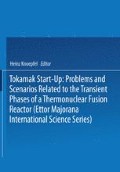Abstract
Control of the release of impurities and their subsequent ingress and exhaust from tokamak plasmas has been the subject of intensive studies aimed at both the prediction of reactor burn condition and the interpretation of results from present experiments. In contrast, control concepts which are specific to current-initiation, current ramp-up and RF heating during start-up of a reactor such as NET have to date received but little attention. The requirements for impurity control during the burn phase can be summarised as follows. Firstly, the necessity to dissipate about 80 MW of non-radiated plasma power without incurring either an excessive release of impurities from the plasma collection surfaces or an unacceptable buildup of impurities within the hot reacting core of the D/T plasma. Secondly, the ability to pump neutral helium gas at the rate of about 2 × 1020 atoms/s in such a manner that the helium ash concentration within the reacting plasma does not exceed ~ 10%. The level of impurity contamination should neither degrade energy confinement (which implies a maximum concentration of 10−3 to 10−4 respectively of medium to high atomic number impurities) nor cause excessive contribution to the plasma β (which implies a typical concentration of light impurities of ~ 10−2). During start-up, the concentration of impurities is not likely to be critical for current-initiation but, especially in the case of high atomic number elements, it becomes significant during the ramp-up and heating phases and it will have a powerful effect upon the ignition margin.
Access this chapter
Tax calculation will be finalised at checkout
Purchases are for personal use only
Preview
Unable to display preview. Download preview PDF.
References
“International Tokamak Reactor Phase Two (part 2)”, IAEA Vienna, Ch.III, to be published.
“Physics of Plasma-Wall Interactions in Controlled Fusion”, eds. R. Behrisch and D. E. Post, NATO ASI, Val-Morin, Canada (1984), to be published by Plenum Press.
M. F. A. Harrison, P. J. Harbour and E. S. Hotston, Nucl. Fusion/Technology, 3: 432 (1983).
M. F. A. Harrison and E. S. Hotston, “Predicted Behaviour of the Single-null Divertor in INTOR”, Report CLM-R226, Culham Laboratory (1982).
M. F. A. Harrison, E. S. Hotston and A. De Matteis, “Plasma Edge Physics for NET/INTOR”, to be published as a NET Report (1985).
P. I. H. Cooke, private communication (1985).
P. J Harbour, Nucl. Fusion, 24: 1211 (1984).
R. Chodura “Plasma Flow in the Sheath and the Presheath of a Scrape-off Plasma”, in Ref.2.
R. Behrisch and W. Eckstein, “Ion Backscattering from Solid Surfaces”, in Ref.2.
J. Bohdansky (1982) in “European Contribution to the INTOR-Phase IIA Workshop”, Euratom, EUR FU BRU/XII-132/82/ EDV30, Brussels (1982), Vol. 2, p. VI - 319.
J. Roth, J. Bohdansky and K. L. Wilson, J. Nucl. Mater., 111 /112: 775 (1982).
M. F. A Harrison, “Atomic and Molecular Collisions in the Boundary Plasma”, in Ref.2.
M. F. A Harrison and E S Hotston, “Predicted Behaviour of the Pumped Limiter of INTOR, Report CLM-R232, Culham Laboratory (1982).
M. Petravic, D. Heifetz and D. Post., Plasma Phys, Controlled Nucl. Fusion Res., Proc. Int. Conf., 10th, London, UK, 1984.
P. J. Harbour and J. G. Morgan, 11th European Conf. on Controlled Fusion and Plasma Physics, Aachen, 1983; EPS 7D Part II (1983) 427.
J. Neuhauser, W. Schneider, R. Wunderlich and K. Lackner, J. Nucl. Mater., 121: 194 (1984).
A. Gibson, J. Nucl Mater., 76 /77: 92 (1978).
J. Neuhauser, K. Lackner and R. Wunderlich, “1-D Tokamak Simulation with Self-Consistent Description of Hydrogen Recycling and Impurity Balance” in “European Contributions to the INTOR Phase IIA Workshop”, Euratom, EUR FU BRU/XII - 132/82/EDV30, Brussels (1982), Vol. 2, p. VI - 47.
W. J. Goedheer, in “European Contributions to INTOR Phase IIA (Part 2) Workshop”, Vol.2, p.III-107, to be published by Euratom.
A. Gibson, in “Conf. Rep. on 3rd European Tokamak Fusion Workshop”, Athens, Dec. 1984, to be published in Plasma Physics and Controlled Fusion.
M. F. A Harrison and E. S. Hotston, in “European Contributions to INTOR Phase IIA (Part 2) Workshop”, Vol.2, p.III-117, to be published by Euratom.
Author information
Authors and Affiliations
Editor information
Editors and Affiliations
Rights and permissions
Copyright information
© 1986 Springer Science+Business Media New York
About this chapter
Cite this chapter
Harrison, M.F.A. (1986). Impurity Control and Its Impact Upon Start-up and Transformer Recharging in NET. In: Knoepfel, H. (eds) Tokamak Start-up. Ettore Majorana International Science Series. Springer, Boston, MA. https://doi.org/10.1007/978-1-4757-1889-8_18
Download citation
DOI: https://doi.org/10.1007/978-1-4757-1889-8_18
Publisher Name: Springer, Boston, MA
Print ISBN: 978-1-4757-1891-1
Online ISBN: 978-1-4757-1889-8
eBook Packages: Springer Book Archive

